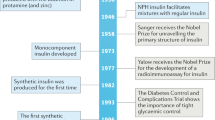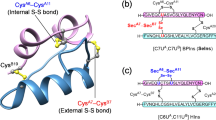Abstract
BY oxidation with performic acid, the insulin molecule can be split into its separate polypeptide chains1. It has now been possible to prepare two fractions from the oxidized insulin : fraction A contains only glycine terminal residues and no arginine, histidine, lysine, phenylalanine or threonine ; fraction B contains 97 per cent phenylalanine terminal residues and all the amino-acids that are present in insulin. The yield of fraction A is more than 25 per cent of the original insulin, indicating that it represents more than one of the peptide chains of the insulin. The yield of fraction B is rather less.
This is a preview of subscription content, access via your institution
Access options
Subscribe to this journal
Receive 51 print issues and online access
$199.00 per year
only $3.90 per issue
Buy this article
- Purchase on Springer Link
- Instant access to full article PDF
Prices may be subject to local taxes which are calculated during checkout
Similar content being viewed by others
References
Sanger, F., Nature, 160, 295 (1947).
Woolley, D. W., Federation Proc., 7, 200 (1948).
Porter, R. R., and Sanger, F., Biochem. J., 42, 287 (1948).
Polson, A., Mosley, V. M., and Wyckoff, R. W. G., Science, 105, 603 (1947).
Consden, R., Gordon, A. H., and Martin, A. J. P., Biochem. J., 41, 590 (1947).
Author information
Authors and Affiliations
Rights and permissions
About this article
Cite this article
SANGER, F. Some Peptides from Insulin. Nature 162, 491–492 (1948). https://doi.org/10.1038/162491a0
Issue Date:
DOI: https://doi.org/10.1038/162491a0
This article is cited by
Comments
By submitting a comment you agree to abide by our Terms and Community Guidelines. If you find something abusive or that does not comply with our terms or guidelines please flag it as inappropriate.



